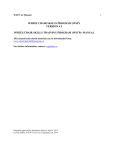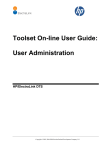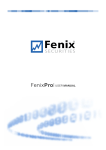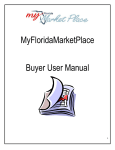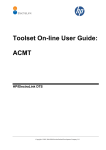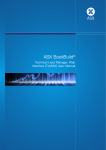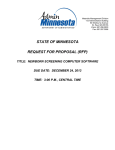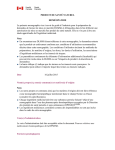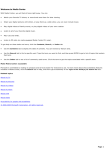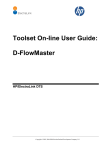Download MIAX Options Exchange User`s Manual
Transcript
MIAX Options Exchange User’s Manual (as of June 12, 2013) MIAX Options Exchange LLC © 2013 Revision Date: June 14, 2013 MIAX User’s Manual v3.0 Table of Contents 1. Introduction .................................................................................................................... 4 2. How to Become a Member of MIAX ................................................................................ 4 3. Types of Membership ..................................................................................................... 5 Market Makers................................................................................................................ 5 Electronic Exchange Members (EEM) ............................................................................ 5 4. Access by Non-Members................................................................................................ 6 5. How MIAX Works ........................................................................................................... 6 Architecture .................................................................................................................... 6 Network Infrastructure .................................................................................................... 7 Data Center Services ..................................................................................................... 7 Connectivity Choices ...................................................................................................... 7 Trading System Features ............................................................................................... 8 Clearing Trade Data ....................................................................................................... 9 Top of Book and Trade Data .......................................................................................... 9 Billing Systems ............................................................................................................... 9 Traded Against Reports .................................................................................................. 9 6. Quote and Order Information .........................................................................................10 Order Types ..................................................................................................................10 Routing to other Exchanges ..........................................................................................11 Order Protections Based on Size and Quantity..............................................................11 MIAX Order Monitor.......................................................................................................12 MIAX Price Protection Process ......................................................................................12 Quote Types ..................................................................................................................13 Minimum Quote Size .....................................................................................................13 Quoting Requirements ...................................................................................................14 MIAX Aggregate Risk Manager (ARM) ..........................................................................15 Self-Trading Protection ..................................................................................................16 Quote Purges ................................................................................................................16 ABBO Crossing Protection ............................................................................................16 7. Trading on MIAX ...........................................................................................................17 Penny Pilot Program......................................................................................................17 Minimum Trading and Pricing Increments on MIAX .......................................................17 Miami International Securities Exchange LLC © 2013 Page 2 of 26 MIAX User’s Manual v3.0 Allocation of Trades .......................................................................................................17 Directed Order Enhanced Allocation ..............................................................................18 PLMM Enhanced Allocation...........................................................................................18 MIAX Opening Process .................................................................................................19 System Settings ............................................................................................................20 Trading Halts and Trading Pauses ................................................................................21 Limit Up/Limit Down (LULD) ..........................................................................................22 Market Wide Circuit Breakers (MWCB)..........................................................................22 8. MIAX Rules ...................................................................................................................23 9. MIAX Fees ....................................................................................................................23 MIAX Fee Schedule.......................................................................................................23 Marketing Fees on the MIAX .........................................................................................23 10. Clearly Erroneous Executions Policy .............................................................................24 11. Hours of Operation and Calendar ..................................................................................24 Trading Hours................................................................................................................24 Holiday Schedule ..........................................................................................................25 12. Contact MIAX ................................................................................................................26 Miami International Securities Exchange LLC © 2013 Page 3 of 26 MIAX User’s Manual v3.0 1. Introduction The MIAX Options Exchange (“MIAX”) created this User’s Manual to assist Members and users of its exchange in understanding the operation of its exchange. The User’s Manual discusses and in some cases, summarizes various MIAX Rules. MIAX’s complete and official Rulebook is available at http://www.miaxoptions.com/regulatory. In the event of a conflict between the User’s Manual and the Rules set forth in the official Rulebook, the Rulebook shall prevail. MIAX operates a fully automated electronic options trading platform for the purpose of buying and selling securities with a continuous, automated matching function. Liquidity is derived from quotes and orders to buy and sell. Quotes and orders are submitted to the Exchange electronically by Members from remote locations. MIAX does not maintain a physical trading floor. There are two categories of Members on MIAX – Market Makers, and all other Members which are known as Electronic Exchange Members (“EEMs”). There are three types of Market Makers on MIAX: (i) Registered Market Makers, (ii) Lead Market Makers, and (iii) Primary Lead Market Makers, each of which is described in Section 4 below. Primary Lead Market Makers are Lead Market Makers, who meet certain additional criteria and obligations and are appointed as a Primary Lead Market Maker by the Exchange. There is just one Primary Lead Market Maker appointed by the Exchange in each option class. Primary Lead Market Makers, Lead Market Makers and Registered Market Makers (collectively, “Market Makers”) have affirmative market making obligations. Information on the quoting requirements for Market Makers can be found in the Quotes and Order Information section of this manual. Access to the Exchange is maintained by way of Trading Permits issued to the Members. Trading Permits are not transferable except in the event of a change in control of a Member. Members are subject to fees for executions on the Exchange as set forth in the Exchange’s Fee Schedule. 2. How to Become a Member of MIAX To become a member of MIAX, a firm must be registered as a broker-dealer, must be a member of at least one other registered options exchange or FINRA, must be able to clear option trades or must clear through a clearing firm and must meet certain additional criteria described by the Exchange and set forth in the Exchange’s Rules. Non-members may also gain access to the Exchange through the use of a Sponsored User arrangement with a Sponsoring Member, in accordance with the Exchange’s Rules. Further information on membership at MIAX, is available on the Exchange’s website: http://www.miaxoptions.com/membership. Miami International Securities Exchange LLC © 2013 Page 4 of 26 MIAX User’s Manual v3.0 3. Types of Membership Market Makers Registered Market Maker A Registered Market Maker (RMM) is a member registered and approved by MIAX as a Market Maker able to meet certain financial requirements and quoting obligations set forth in MIAX rules. Further information regarding the obligations and requirements for RMMs and information regarding RMM trade allocations can be found in MIAX Rules, Chapters V and VI. Lead Market Maker A Lead Market Maker (LMM) is a Market Maker that is held to, and maintains, additional financial requirements, and higher quoting obligations than a Registered Market Maker. Only LMMs (including those appointed as a Primary Lead Market Maker, may participate in the Exchange’s Directed Order program and receive Marketing Fee payments for orders directed to them by an Electronic Exchange Member (“Directed Orders”). When appropriate, LMMs are also entitled to certain enhanced trade allocations in accordance with the Directed Order program. Further information regarding the obligations and requirements for LMMs and information regarding enhanced trade allocations and entitlements can be found in MIAX Rules, Chapters V and VI. Primary Lead Market Maker A Primary Lead Market Maker (PLMM) is an LMM that is held to, and maintains, additional financial requirements, order flow commitments and additional quoting obligations in order to be appointed as the PLMM in an option class. There is only one PLMM appointed to each class of options traded on MIAX. A PLMM may receive certain enhanced trade allocations and entitlements when appropriate, including those associated with the Directed Order program. Further information regarding the obligations and requirements for a PLMM and information regarding enhanced trade allocations and other entitlements can be found in MIAX Rules, Chapters V and VI. Electronic Exchange Members (EEM) An EEM is an Exchange Member that is permitted to submit either proprietary orders or orders it represents as agent to the MIAX System. An EEM is not permitted to act as a Market Maker. Miami International Securities Exchange LLC © 2013 Page 5 of 26 MIAX User’s Manual v3.0 4. Access by Non-Members Non-Members may access the Exchange pursuant to Rules governing “sponsored access” to the Exchange. The Exchange permits access by entities (“Sponsored Users”) whose access is authorized in advance by entering into an arrangement with a Member (“Sponsoring Member”) in accordance with Exchange Rules. Sponsored Users must agree to comply with all applicable Rules of the Exchange governing the entry, execution, reporting, clearing and settling of orders in securities eligible for trading on the Exchange. Further information about Sponsored Access can be found in MIAX Rules, Chapter II. 5. How MIAX Works Architecture Market Makers send quotes to the Exchange’s systems through the MIAX Express Interface (MEI). Electronic Exchange Members send orders to the Exchange’s systems through the MIAX FIX Order Interface (FOI) gateway. The MIAX Trading System is designed to be highly scalable, efficient, fast, reliable, robust and flexible. The Exchange deploys multiple matching engines, each engine performing the trade match function for a defined set of option classes. Market Makers connect to the System via the MIAX Express Interface (MEI), using a proprietary protocol for the transmission of quotes and other messages to and from the Exchange. A Market Making firm is allocated two MEI connections for each Exchange matching engine that performs the trade matching function for option classes in which the Member is assigned as a Market Maker. EEMs connect to the System via the MIAX FOI gateway, using the industry standard FIX protocol with MIAX specific extensions, for the transmission of orders and other messages to and from the Exchange. The MIAX FOI validates incoming orders and forwards them to the appropriate matching engine. Executions and cancelation notifications are provided through these same interfaces. The matching engines of the Exchange each handle a defined set of option classes, which may be reallocated on a periodic basis in order to ensure that system load is balanced across the MIAX System. Each matching engine compares the limit price of all incoming quotes and orders with those quotes and orders already resting on the MIAX Book. The matching engine matches liquidity as available, calculates the MIAX Best Bid and Best Offer (the MBBO), monitors the other markets’ displayed prices and determines when, and if, a trade can occur. If a newly arrived quote or order is marketable against the existing MIAX Book, and the MBBO is Miami International Securities Exchange LLC © 2013 Page 6 of 26 MIAX User’s Manual v3.0 equal to or better than the best consolidated quote, an immediate match is made and allocations are communicated back to the trade participants. If another market is disseminating a price superior to MIAX’s displayed price, orders may be routed to the better priced market(s). Quotes and orders may be managed within the MIAX System so as not to lock the NBBO price. Network Infrastructure The MIAX network was designed to complement the MIAX Trading System and was built from the ground up to address the performance and security needs of a high speed trading platform. MIAX network infrastructure utilizes a 40Gbps backbone and10Gbps switch technology for maximum throughput and minimal latency. Data Center Services MIAX has partnered with Equinix, a world-class provider of data center services, to host the Trading System’s data center infrastructure in its NY2 and NY4 locations. MIAX has implemented this dual data center approach to achieve redundancy in a similar geographic locality for primary data center services. (This proximate location protects against a single site failure while minimizing customer impact.) Customers with very low latency demands can cross-connect to the MIAX systems from elsewhere within the Equinix facility. Notable Data Center Services o SSAE16 compliant Data Centers o Redundant power feed sourced from district substations o Redundant power and cooling distribution paths within the facility o Concurrently maintainable (N+1 or greater resiliency) o On-site backup power generation Enhanced Security Services o State of the art security o Hand Scanners o Card Readers o Cameras Buildings designed to withstand fires, earthquakes, hurricanes and other environmental threats. Manned 24/7. A third Data Center is located in a geographically diverse location for Disaster Recovery. MIAX maintains two additional Point of Presence Data Center locations for access to primary or Disaster Recovery Data Centers. Connectivity Choices Miami International Securities Exchange LLC © 2013 Page 7 of 26 MIAX User’s Manual v3.0 Users are strongly encouraged to establish connectivity to at least two data centers to minimize the possibility of service disruption. MIAX supports the following connectivity options: o Cross-Connect: Users that are co-located in the Equinix NY2 or NY4 data centers may request an in-house cross-connect from the User’s Point of Entry (POE) to MIAX. o Point-to-point: Users may connect point-to-point using leased lines or other network methods (e.g. Ethernet, etc.). (Users are responsible for providing colocation space for independently owned equipment.) o Remote POPs (Point of Presence): Users may connect either through crossconnect if co-located or Point-to-Point to one of two major POPs in which MIAX has a presence. The POPs are considered extended cross-connect to all three data center locations. (Users are responsible for providing co-location space for independently owned equipment.) o Metro Ethernet/Dark Fiber: Users may connect via Metro Ethernet or a dark fiber provider. Trading System Features The MIAX Trading System was developed specifically for the unique functional and performance demands of derivatives trading. Our System provides the proper protections, low latency and throughput that is essential to the success of the trading community. The MIAX System provides: o Extreme performance and scalability. o Best in class customer interface features and performance. MIAX FIX Order Interface (FOI) gateway for orders. o Each FOI is capable of processing more than 7,700 order messages per second. MIAX Express Interface (MEI) offers direct connections to the matching engine for highspeed mass quoting. o Each MEI interface is capable of processing more than 100,000 quote messages per second. MIAX Top of Market (ToM) provides low latency access to MIAX market data. o The MIAX ToM data feed service produces market data across 24 multicast channels. Each channel is capable of transmitting more than 950,000 messages per second during peak periods. MIAX Clearing Trade Drop (CTD) for real-time high speed clearing trade drops. o The MIAX CTD interface is capable of processing more than 20,000 clearing trade messages per second. A next-generation highly-automated Quality Assurance platform runs a full battery of tests against the System every night to ensure a high level of reliability and unprecedented confidence in System updates. State-of-the-art monitoring and systems security. Miami International Securities Exchange LLC © 2013 Page 8 of 26 MIAX User’s Manual v3.0 A software and hardware architecture that results in minimizing the demands on power, space and cooling while allowing for rapid scalability, standard setting resiliency and superior fault isolation. For more details on connecting to the MIAX trading platform, please see the Interface Connectivity Specifications on the MIAX web site: http://www.miaxoptions.com/connectivity Clearing Trade Data Clearing trade data is available to member firms via the MIAX Clearing Trade Drop (CTD). This is a low-latency, real-time feed providing clearing trade information to the parties of a trade, clearing firms and/or other entitled designated recipients. Recipients connect to the CTD using a proprietary protocol and one or more CTD connections for each Exchange matching engine. Top of Book and Trade Data Top of Book and Trade Data is made available over the MIAX Top of Market data feed (ToM). ToM is available to all MIAX participants. ToM also includes MIAX specific notifications relating to timers, away order routing and other real-time Exchange System functions. Recipients connect to ToM using a proprietary protocol and for the purpose of redundancy may subscribe to two identical connections (ToM “A” and ToM “B”) for each Exchange matching engine. Billing Systems Billing information is available to MIAX Member Firms via the My MIAX Billing Portal. Through this portal, Member Firms have access to daily transaction fee details and summary reports. These reports include fee totals for each transaction type by Member Participant Identifier (“MPID”), YTD Period, Execution Venue, Origin, or Contra Origin. Detailed pool summary reports are also provided for Marketing Fees. All of the summary reports and trade level detail may be exported to Excel within search criteria specified by the user. Monthly invoices are also available on the portal and may be viewed at any time throughout the billing period. Transaction fees are accumulated in real time and non-transaction fees charges are assessed and available on the portal on the last day of the month. When the invoice is closed for the billing period, a notification is sent via email. To obtain access to the My MIAX Billing Portal, Member Firms should send requests to [email protected]. Traded Against Reports MIAX Traded Against Reports (“Reports”) provide Member Firms with details of their trading activity. The Reports include key information about transaction fees, directed orders, marketing fees, and the NBBO and MBBO at the time of a transaction. In addition, the reports contain Miami International Securities Exchange LLC © 2013 Page 9 of 26 MIAX User’s Manual v3.0 extensive information about the contra side of trades in which a Member firm participates. In addition to detailed trade information, LMMs receive limited trade data for all executions resulting from orders directed to them. PLMMs receive limited trade data for all executions in their assigned PLMM classes. Such trade information is transmitted without participant details. This information is intended to assist firms in monitoring and evaluating their directed order and trading activity on the MIAX. There are two types of Reports available—the Market Maker Report and the Electronic Exchange Member Report as described below:: Market Maker Report– Includes all trades in which the Market Maker participated as well as: o o o o o Executions resulting from orders directed to, and traded by, the Market Maker. Executions resulting from orders directed to the Market Maker, but traded by others. Executions resulting from orders directed to others and traded by the Market Maker. Executions resulting from orders not directed and traded by the Market Maker. Executions resulting from all other orders in a class to which the Member Firm is appointed as the PLMM. Electronic Exchange Member Report– All executions resulting from orders sent by the EEM o o o Executions resulting from orders directed by the EEM and traded by the Directed LMM. Executions resulting from orders directed by the EMM and traded by parties other than the Directed LMM. Executions resulting from orders not directed by the EEM. The reports are available at the end of the day via firm specific secure FTP locations. This is the same location where end of day GTC and end of day clearing reports can be found. To sign up for Traded Against Reports please contact MIAX Trade Operations at: [email protected] 6. Quote and Order Information Order Types The following are some of the order types described in the MIAX Rules that, except as described below, are available for use on the Exchange as of the date of this Manual: Miami International Securities Exchange LLC © 2013 Page 10 of 26 MIAX User’s Manual v3.0 Market – An order to buy or sell a stated number of options contracts at the best available price. Limit – An order to buy or sell a stated number of options contracts at or better than a specified price. Fill-or-Kill orders (FOK) – A limit order to be executed in full upon receipt at a single price or cancelled. Immediate-or-Cancel (IOC) – An order to be executed in whole or part upon receipt with any unexecuted portion cancelled. Auction or Cancel (AOC) – An order used to provide liquidity during a specific Exchange process such as an Opening Imbalance, Liquidity Refresh Pause or Route Timer. Intermarket Sweep Orders (ISO) – A limit order designated by the submitting member as an ISO trades without regard to MIAX price protections or protected quotations on other markets. Do Not Route (DNR) – An order that will never be routed outside of the MIAX regardless of the prices displayed by away markets. A DNR order will never execute at a price inferior to the NBBO and when necessary, its display price will be managed so as not to lock or cross the NBBO. Opening (OPG) – An order that is only valid during the Opening Process. Day Limit Order – An order to buy or sell which, if not executed, expires at the end of trading in the security on the day on which it was entered. Good ‘Til Cancelled (GTC) – An order to buy or sell, which if not executed, remains in effect until cancelled or until the underlying option expires. Attributable – An Attributable Order is a market or limit order which displays the entering firm’s Market Participant Identification (MPID). Use of Attributable Orders is voluntary. Attributable Orders are expected to be available in the summer of 2013. Each of these types of orders is described in detail in MIAX Rule 516. The Exchange maintains a full audit trail of every order submitted to the Exchange’s System. Members may receive status reports regarding orders submitted to the Exchange or change or cancel an order at any time before that order is executed on the Exchange. Routing to other Exchanges Routing services are provided for routing to all Options Exchanges in the United States and are fully compliant with the Options Locked and Crossed Markets Plan (the “Plan”). The MIAX System routes Public Customer orders to away markets displaying liquidity at the NBBO when required to satisfy a protected quotation under the Plan. A full description of MIAX routing functionality is available in MIAX Rule 529. Order Protections Based on Size and Quantity The MIAX System offers protections from potentially erroneous executions or obvious errors based on the size of orders, number of open orders and number of open contracts. Miami International Securities Exchange LLC © 2013 Page 11 of 26 MIAX User’s Manual v3.0 Members are required to submit global default settings for their Firm as a part of the MIAX Membership Application process for all protections based on size or quantity. Firms may provide updated settings by contacting the MIAX Trade Operations staff. The most recent settings will remain effective in the MIAX System until a subsequent update is received by the Exchange. All settings are put in place on a Firm-wide basis and are not individually selectable by FOI connection or MPID. The following protections are available: Maximum size for a single order. Maximum number of open orders. o This includes partially filled orders. Maximum number of open contracts. o This includes any contracts remaining from unfilled and partially filled orders. MIAX Order Monitor In order to reduce the incidence of errors on the Exchange, the MIAX System includes the MIAX Order Monitor (MOM), as described in Exchange Rule 519. The MIAX Order Monitor prevents orders that violate certain pre-defined price limits from executing or being placed on the MIAX Book. These price protections include: Rejection of market orders to sell when the national best bid is zero (0) and the national best offer is greater than $0.10. Rejection of market orders to buy or sell when the NBBO is $5.00 wide or greater. Rejection of limit orders priced though the opposite side of the NBBO by the lesser of: a) 50% of the opposite side price, or b) $2.50. Protections under the MIAX Order Monitor do not apply to orders received prior to, or during the Opening Process, to Intermarket Sweep Orders (ISO), or to GTC orders resting from a prior session. MIAX Price Protection Process The System applies a price protection process, as described in MIAX Rule 515, to all orders other than orders for the account of a Market Maker, limiting executions to no more than one MPV through the NBBO as captured at time of order receipt. Members may submit written instructions to the Exchange designating their orders as eligible for automatic resubmission when the order or any remaining part of the order has been automatically cancelled by the System. The resubmitted order is automatically submitted by the System as a new order. Immediate or Cancel, Fill or Kill or Intermarket Sweep Orders are not eligible for automatic resubmission. Miami International Securities Exchange LLC © 2013 Page 12 of 26 MIAX User’s Manual v3.0 Quote Types The MIAX System accepts single-sided quotes. Market Makers may independently update bids and offers and are not required to send bid/ask pairs with every submission, provided they are compliant with their quoting obligations. Market Makers may submit a single standard quote and multiple eQuotes for each individual option, and may have multiple quotes active in a single option at any time. The following are some of the quote types described in the MIAX Rules that are available for use on the Exchange: Standard – A Standard quote cancels or replaces the Market Maker’s previous quote, if any. For each Option, a Market Maker may only have a single Standard quote per side. eQuote - An eQuote is a quote with a specific time in force that does not automatically cancel and replace a previous Standard quote or eQuote. o o o o o Fill-or-Kill eQuote (FOK) – A quote to be executed in full upon receipt at a single price or cancelled. Immediate-or-Cancel eQuote (IOC) – A quote to be executed in whole or part upon receipt with any unexecuted portion cancelled. Auction or Cancel eQuote (AOC) – A quote used to provide liquidity during a specific Exchange process such as an Opening imbalance, Liquidity Refresh pause or Route Timer. Intermarket Sweep eQuote – A quote designated by the submitting member as an Intermarket Sweep eQuote trades without regard to MIAX price protections or protected quotations on other markets. Opening eQuote (OPG)– A quote that is only valid during the Opening Process. Further information regarding quote types available on the MIAX can be found in MIAX Rule 517. Minimum Quote Size Standard Quotes – The MIAX System accepts Standard quotes in a single-sided format. Standard quotes may be delivered in bulk with up to 50 single-sided quotes in an individual bulk quote message. Standard quotes must meet a minimum initial size when delivered to the Exchange. The Exchange-wide global default for Standard quote minimum size is ten (10) contracts. From time-to-time, the minimum Standard quote size may vary by class. Changes to the minimum Standard quote size will be announced via a Regulatory Circular and posted in the Regulatory section of the Exchange’s website: http://www.miaxoptions.com/regulatory. Further information regarding quoting requirements can be found in MIAX Rule 604. eQuotes – The MIAX System accepts eQuotes in a single-sided, single quote format. eQuotes must meet a minimum initial size when delivered to the Exchange. The Exchange-wide global default for all eQuote types is one (1) contract. From time-to-time Miami International Securities Exchange LLC © 2013 Page 13 of 26 MIAX User’s Manual v3.0 the minimum eQuote size for certain types of eQuotes may vary. Changes to the minimum eQuote size will be announced via a Regulatory Circular and posted in the Regulatory section of the Exchange’s website: http://www.miaxoptions.com/regulatory. Further information regarding quoting requirements can be found in MIAX Rule 604 and further information in eQuotes can be found in MIAX Rule 517. Quoting Requirements PLMM Quoting Requirements o o o o o o A Market Maker appointed as the PLMM in a class is required to submit valid width quotes in each series not later than one minute following the opening of the underlying security. A Market Maker appointed as the PLMM in a class must meet a minimum continuous quoting requirement 90% of the time the class is open for trading on the MIAX. A Market Maker appointed as the PLMM in a class must, at a minimum, quote in lesser of 99% of the series, or 100% of the series minus one put-call pair, in each class in which the PLMM is assigned. The continuous quoting requirements will not apply to adjusted option series. These obligations will apply to all appointed classes collectively for each PLMM. Compliance with this obligation will be determined on a monthly basis. However, determining compliance with the continuous quoting requirement on a monthly basis does not relieve the PLMM of the obligation to provide continuous twosided quotes on a daily basis, nor will it prohibit the Exchange from taking disciplinary action against a PLMM for failing to meet the continuous quoting obligation each trading day. The total number of contracts executed during a quarter by a PLMM in options classes to which it is not appointed may not exceed 10% of the total number of contracts traded by such PLMM in classes to which it is appointed and with respect to which it was quoting. Also included in this 10% limitation are contracts executed in the PLMM’s appointed classes that resulted from the execution of an order submitted by the PLMM LMM Quoting Requirements o o o o A Market Maker appointed as an LMM in a class must meet a minimum continuous quoting requirement of 90% of the time the class is open for trading on the MIAX. A Market Maker appointed as an LMM in a class must, at a minimum, quote in 90% of the series in each class in which the LMM is assigned. The continuous quoting requirements will not apply to adjusted option series. The continuous quoting requirements will not apply to series with a time to expiration of nine months or greater. Miami International Securities Exchange LLC © 2013 Page 14 of 26 MIAX User’s Manual o o v3.0 These obligations will apply to all appointed classes collectively for each LMM. Compliance with this obligation will be determined on a monthly basis. However, determining compliance with the continuous quoting requirement on a monthly basis does not relieve the LMM of the obligation to provide continuous two-sided quotes on a daily basis, nor will it prohibit the Exchange from taking disciplinary action against a LMM for failing to meet the continuous quoting obligation each trading day. The total number of contracts executed during a quarter by an LMM in options classes to which it is not appointed may not exceed 10% of the total number of contracts traded by such LMM in classes to which it is appointed and with respect to which it was quoting. RMM Quoting Requirements o o o o o o A Market Maker appointed as an RMM in a class must meet a minimum continuous quoting requirement of 90% of the time the class is open for trading on the MIAX. A Market Maker appointed as an RMM in a class must, at a minimum, quote in 60% of the series available for trading in that class on the MIAX. The continuous quoting requirements will not apply to adjusted option series. The continuous quoting requirements will not apply to series with a time to expiration of nine months or greater. These obligations will apply to all appointed classes collectively for each RMM. Compliance with this obligation will be determined on a monthly basis. However, determining compliance with the continuous quoting requirement on a monthly basis does not relieve the RMM of the obligation to provide continuous two-sided quotes on a daily basis, nor will it prohibit the Exchange from taking disciplinary action against a RMM for failing to meet the continuous quoting obligation each trading day. The total number of contracts executed during a quarter by an RMM in options classes to which it is not appointed may not exceed 25% of the total number of contracts traded by such RMM in classes to which it is appointed and with respect to which it was quoting. MIAX Aggregate Risk Manager (ARM) The MIAX Aggregate Risk Manager (ARM) protects Market Makers by limiting the number of contracts they execute in a class on the MIAX within a brief period of time. This Exchangeprovided risk management facility helps protect Market Makers from assuming undue risk during times of unusual market conditions, and quote more aggressively during normal market conditions, thus promoting the execution of more trades and increased profitability without subjecting them to undue risk. The MIAX ARM tracks the number of contracts traded by a Market Maker (represented as a percentage of quote size) in an assigned option class within a specified time period. The Market Maker establishes a percentage of their quotations Miami International Securities Exchange LLC © 2013 Page 15 of 26 MIAX User’s Manual v3.0 (Allowable Engagement Percentage) and the time period for each option class. When an execution against a Market Maker’s Standard quote occurs, the System looks back over the specified time period to determine whether the execution is of sufficient size to trigger the Aggregate Risk Manager. The System engages the Aggregate Risk Manager when it has determined that a Market Maker has traded a number of contracts equal to or above their Allowable Engagement Percentage during the time period. The Aggregate Risk Manager then automatically removes the Market Maker’s quotations from the Exchange's disseminated quotation in all series of that particular option class until the Market Maker sends a re-entry flag and submits new quotations in the affected class. Self-Trading Protection The MIAX System contains certain protections to prevent a Market Maker from interacting with their own quote or order. In the event that a Market Maker sends a quote or order priced at a limit that would allow it to interact with a quote or order from that same Market Maker MPID that is resting on the opposite side of the market, the resting quote or order from that Market Maker MPID will be cancelled by the System and the new quote or order will be accepted by the System. Quote Purges Firm Initiated and Firm Requested Purges o – Firms may initiate quote purges via MEI with a single command Class Purges – Purge all quotes in a specific class for a given MPID. MPID (Wildcard) Purge – Purge every quote for all classes on a specified matching engine for a given MPID. o MIAX Trading Operations has the ability to quickly cancel all quotes by Firm request for the following categories Class and MPID. Globally by MPID. Globally by Firm. MIAX Initiated and Automatic Purges o Port Disconnect Purges – If all ports for a given Firm on a specific matching engine disconnect, all quotes for all of that Firm’s MPIDs will be purged for that matching engine. o Loss of Heartbeat – If all MEI applications on a specific matching engine fail for a given Firm, all quotes are purged for all of that Firm’s MPIDs on that matching engine. o Trading Halt – In the case of a trading halt, all quotes in the class are purged. o Non-tradable Series – When a series is made non-tradable, all quotes for the series are purged. ABBO Crossing Protection (Management of Non-Routable Liquidity) Miami International Securities Exchange LLC © 2013 Page 16 of 26 MIAX User’s Manual v3.0 The MIAX Exchange System will not disseminate a locked or crossed market unless such dissemination is done in accordance with Exchange Rules or a National Market System plan (NMS) governing locked and crossed markets. When the System receives a quote or nonroutable order that would lock or cross an away market, the System will display such quote or non-routable order at a price that is one MPV away from the current opposite side NBBO and book the quote or order at an undisplayed price that will lock the current opposite side NBBO. Should the NBBO price change to a price that is inferior to the price of the undisplayed booked quote or order, such quote or order’s undisplayed price will continuously re-price to lock the new NBBO, and the quote or order’s displayed price will continuously re-price one MPV away from the new NBBO until the quote or order reaches its original limit price, is fully executed, or is cancelled. 7. Trading on MIAX Penny Pilot Program MIAX participates in the Penny Pilot program, which provides for the quoting and trading of certain option classes in penny increments. Minimum Trading and Pricing Increments on MIAX Options in classes not in the Penny Pilot Program have a Minimum Price Variation (MPV) for MBBO display in $0.05 increments if the affected series has a price of under $3.00, and in $0.10 increments if the affected series has a price of $3.00 or higher. Options in classes in the Penny Pilot Program have an MPV for MBBO display in $0.01 increments under $3.00 and $0.05 increments for prices of $3.00 or greater. Notwithstanding the above, options overlying certain ETFs and Holders may be priced and disseminated in increments of $0.01, regardless of the price of the option. Allocation of Trades MIAX supports pro-rata trade allocation. Pro-rata trade allocation matches an initiating order against resting interest on the MIAX electronic book using a methodology that ensures that the best price has priority, but also allocates in a method that rewards Market Makers submitting continuous narrow and liquid two-sided quotes. When multiple participants with interest at the same price exist, MIAX uses an algorithm that groups the participants into three allocation tiers based on their participation type in the priority order defined below: Priority Customer Orders. Priority Quotes, after all Priority Customer Orders at the same price have been executed in full. All remaining Professional Orders and non-Priority Quotes, after all Priority Customer Orders and Priority Quotes have been executed in full. Miami International Securities Exchange LLC © 2013 Page 17 of 26 MIAX User’s Manual v3.0 A Market Maker quote that does not meet the defined Priority Width will be treated as Professional Interest for purposes of Enhanced Allocations and pro-rata trade allocation. The intent of the Exchange is to define the Priority Quote at a tighter bid/ask spread differential than the maximum valid bid/ask spread width for most options. Priority Quote may be defined on class-by-class or an option-by-option basis by the Exchange. The Priority Quote width standard established by the Exchange can have bid/ask differentials as narrow as one MPV, as wide but never wider than the than the bid/ask differentials outlined in MIAX Rule 603(b)(4), or somewhere in between. The Priority Quote width standard will be established by the Exchange and filed with the Commission in accordance with Section 19 of the Exchange Act and Rule 19b-4 thereunder. Notwithstanding the foregoing, until such time as the Exchange has submitted and received approval of a rule change establishing narrower bid/ask differentials, the priority quote width standard will be the bid/ask differentials outlined in MIAX Rule 603(b)(4). Priority Quotes are required for Market Makers to be eligible for the Market Maker allocation tier (tier two). Priority Quotes are also required to be eligible to receive an Enhanced Allocation when the Primary Lead Market Maker or Directed Lead Market Maker overlays are in effect. Directed Order Enhanced Allocation Directed Orders o Directed Orders are orders that have identified a market making participant (Directed Market Maker, or “DLMM”) as the preferred contra party to the trade. If the Directed Market Maker has a Priority Quote at the NBBO at the time the Directed Order is received, the Directed Market Maker will receive the greater of i) an enhanced allocation of 60% or ii) their pro-rata share if there is one other Market Maker with Priority Quotes at the NBBO, and the greater of i) an enhanced allocation of 40% or ii) their pro-rata share if there are two or more other Market Makers with Priority Quotes at that price level. In all cases Market Maker allocations occur only after all Priority Customer interest at that price level has been satisfied. Submitting a Directed Order o Directed Orders may be submitted any MIAX EEM on behalf of a Priority Customer. o Instructions to direct the order must be indicated in the FIX order message. Receiving a Directed Order o MIAX Market Makers that are approved as a Lead Market Maker may receive Directed Orders. PLMM Enhanced Allocation Orders Directed to the PLMM Miami International Securities Exchange LLC © 2013 Page 18 of 26 MIAX User’s Manual v3.0 o If the PLMM has a Priority Quote at the NBBO at the time the order is received and the PLMM is identified as the preferred contra party to the trade (the DLMM), the PLMM enhanced allocation described below will prevail over the DLMM enhanced allocation. Allocation of i) orders directed to the PLMM and ii) non-directed orders (excludes orders directed to another LMM (the DLMM) when that DLMM has a Priority Quote at the NBBO) o A PLMM with a Priority Quote at the NBBO at the time the order is received is entitled to receive the entire allocation of incoming orders with a size of 5 contracts or less (provided that the PLMM’s disseminated quote is for a size of at least 5 contracts). A PLMM with a Priority Quote at the NBBO at the time an order of greater than 5 contracts is received will receive the greater of i) an enhanced allocation of 60% or ii) their pro-rata share if there is one other Market Maker with Priority Quotes at the NBBO, and the greater of i) an enhanced allocation of 40% or ii) their pro-rata share if there are two or more other Market Makers with Priority Quotes at that price level. In all cases Market Maker allocations occur only after all Priority Customer interest at that price level has been satisfied. MIAX Opening Process The MIAX Opening Process begins when the quoting requirements and other provisions of MIAX Rule 503 have been satisfied. Once the Opening Process begins, if there are no quotes or orders that lock or cross each other, the System will open by disseminating the Exchange’s best bid and offer among quotes and orders that exist in the System at that time. If there are quotes or orders that lock or cross each other, the System will calculate an opening price taking into consideration all valid Exchange quotes and all valid orders, together with other exchanges’ markets for the series and identify the price at which the maximum number of contracts can trade. If that price is within the highest valid width quote bid and lowest valid width quote offer and leaves no imbalance, the Exchange will open at that price, executing marketable trading interest, as-long-as the opening price includes only Exchange interest. If the calculated opening price is outside of the NBBO, or equals the NBBO and requires interest from another exchange to satisfy all interest at that price, the System will broadcast a System Imbalance Message and initiate a Route Timer (not to exceed one second) to allow additional orders or quotes to be submitted. If no new interest is received during the Route Timer, the System will route to other markets disseminating prices better than the Exchange’s opening price, execute marketable interest at the opening price on the Exchange, and route to other markets disseminating prices equal to the Exchange opening price if necessary. If new interest is received during the Route Timer, the System will recalculate the opening price taking such new interest into account. Then, if there is no longer an imbalance, the System will execute marketable interest at the opening price on the Exchange and route the remainder to other markets. If the Opening Process results in an imbalance that cannot be satisfied within the Exchange’s opening Quote Range, the System will begin an imbalance process by establishing an Expanded Quote Range (EQR), which will represent the limits of the range in which transactions may occur during the Opening Process. The EQR is established by subtracting the amount Miami International Securities Exchange LLC © 2013 Page 19 of 26 MIAX User’s Manual v3.0 specified in the EQR table from the Quote Range bid and adding the amount specified in the table to the Quote Range offer. The EQR table can be found in the Trading System Settings section of the Members tab on the Exchange’s website: http://www.miaxoptions.com. If there is sufficient size on the Exchange on the opposite side of the market from the imbalance to execute all opening marketable interest at a price that is within the established EQR without leaving an imbalance, the System will open the affected series for trading at that price by executing opening marketable interest on the System, as long as the System does not trade through the ABBO. If all opening marketable size cannot be completely executed at or within the EQR without trading through the ABBO, the System will initiate an imbalance process. The System will broadcast a System Imbalance Message and initiate an Imbalance Timer (not to exceed three seconds) to allow additional orders or quotes to be submitted. At the end of the Imbalance Timer, if quotes and orders submitted during the Imbalance Timer, or other changes to the ABBO, would not allow the entire imbalance amount to trade at the Exchange at or within the EQR without trading through the ABBO, the System will send a new System Imbalance Message and initiate a Route Timer (not to exceed one second). If during the Route Timer, interest is received by the System which would allow all interest to trade on the System (i.e., there is no longer an imbalance) at the opening price without trading through other markets, the System will trade and the Route Timer will end early. At the end of the Route Timer, the System will execute as many of the marketable contracts as possible by: (i) routing the number of contracts that will satisfy interest at other markets at prices better than the Exchange opening price; (ii) trading available contracts on the Exchange at the Exchange opening price; and/or (iii) routing a number of contracts that will satisfy interest at other markets at prices equal to the Exchange opening price. If not all of the marketable contracts on the Exchange can be executed, the System may repeat the imbalance process up to three times. More information on acceptable bid/ask spreads for the Opening and other System parameters relating to the Opening Process can be found under System Settings on the Exchange’s website. System Settings All current System settings are posted in the Trading System Settings section of the Members tab on the Exchange’s website: http://www.miaxoptions.com. Changes to System Settings are also published by the Exchange as either Regulatory Alerts or Regulatory Circulars, as required. Some settings are also listed below for your convenience. Please be sure to check the Exchange’s website for the most current information. The following tables governing valid quote ranges are available on the Exchange’s website o Opening Range Table. o Opening Valid Quote Width Table. o Opening Priority Quote Width Table. o Free Trading Valid Width Quote Table. o Free Trading Priority Quote Table. Opening Underlying Pause – The Opening Underlying Pause is the length of time the System will pause after the opening of the underlying security to allow the marketplace to absorb pricing information. o 0.500 Second Miami International Securities Exchange LLC © 2013 Page 20 of 26 MIAX User’s Manual v3.0 Post Halt Notification – The Post Halt Notification period is the length of time prior to reopening after a manual trading halt that a System notice is distributed over the Exchange’s data feeds. o 20.000 Seconds. Route Timer – The Route Timer is the length of time the System waits prior to routing a Public Customer order to an away market. o 0.500 Seconds Liquidity Refresh Pause – The Liquidity Refresh Pause is the length of time the System waits prior to trading or routing at the next Minimum Price Variation if the MIAX best bid or offer was the National Best Bid or Offer, was exhausted and contained a Market Maker quote. o 0.500 Seconds. Imbalance Process Timer – The Imbalance Process Timer is the length of time the System will wait for additional liquidity during the Opening Process if there is marketable unexecuted interest on one side of the market. o 1.000 Seconds. Number of Imbalance Process Iterations – the System will repeat the Imbalance Process three (3) times if there continues to be marketable unexecuted interest on one side of the market. Standard Quote Minimum Size – The Standard Quote minimum size default setting is ten (10) contracts; however the default setting may be as few as one (1) contract for certain option classes. eQuote Minimum Size – The eQuote minimum size is the minimum size is one (1) contract. Automatic Order Re-entry – For firms that have submitted written instructions for automatic order re-entry in advance, a marketable order will be automatically re-entered by the Exchange two hundred (200) times if it is not eligible to be placed on the Exchange’s limit order book and is not fully executed. Trading Halts and Trading Pauses The System automatically halts trading when the primary market for the underlying security disseminates a halted or paused condition. Under certain circumstances, in the interest of a fair and orderly market, the Exchange may elect to manually halt trading in an individual option class, a group of option classes or all option classes Exchange wide. The Opening Process will not begin if the underlying security is halted or paused. If the Opening Process is in progress at the time of the halt, the System will interrupt the Opening Process prior to its completion, will halt trading in options already opened and will prevent unopened options from opening. After a trading halt on MIAX, the System will reopen following the same processes as the Opening Process, except that the Primary Exchange will be used in place of the MIAX Primary for Opening Exchange. Market Makers must send a re-entry flag prior to submitting quotes. Miami International Securities Exchange LLC © 2013 Page 21 of 26 MIAX User’s Manual v3.0 The following MIAX timers, if in progress at the time of a halt or pause in the underlying security, will be discontinued and will not result in an execution: Opening Imbalance Timer. Route Timer. Liquidity Pause. All Standard quotes and eQuotes existing at the time of the trading halt on MIAX will be purged by the System. Quotes sent prior to the conclusion of the purge will be rejected. A re-entry flag is required to resume submitting quotes after the purge is complete. Post Halt Notifications, including the symbol and expected time of re-opening, will be distributed over the MEI and ToM data feeds 20 seconds prior to the resumption of trading after a manual trading halt. Limit Up/Limit Down (LULD) MIAX is participating in the industry initiative for Limit Up/Limit Down which began on April 8, 2013. LULD functionality on MIAX is in effect when the underlying NMS Stock has entered into a Limit State or Straddle State. Once an NMS Stock has entered either a Straddle State or Limit State: The Exchange will not open an affected option. After the opening, the Exchange will: o reject all incoming market orders submitted into the Exchange System. o cancel all unexecuted market orders existing within the Exchange System, except that market orders to sell an option received when the national best bid is zero and the Exchange’s disseminated offer is equal to or less than $0.10 that have been converted to limit orders to sell pursuant to Rule 519(a) will not be cancelled by the Exchange’s System. In addition, once an NMS Stock has entered either a Limit or Straddle State, the Exchange shall relieve Exchange Market Makers from the following quotation obligations for options on the affected underlying NMS Stock: the bid/ask differential requirements set forth in MIAX Rule 603(b)(4); the minimum size requirement set forth in MIAX Rule 604(b)(2); the requirement to submit two-sided quotes set forth in MIAX Rule 604(c); and the continuous quoting obligation set forth in MIAX Rule 604(e) When an underlying NMS Stock is subject to a Trading Pause, the Exchange System will halt trading in options overlying the affected NMS Stock pursuant to MIAX Rule 504(c). Market Wide Circuit Breakers (MWCB) Miami International Securities Exchange LLC © 2013 Page 22 of 26 MIAX User’s Manual v3.0 MIAX is participating in the industry initiative Market Wide Circuit Breakers, which began on April 8, 2013. MWCB Functionality o MWCB halts are treated by the System in the same fashion as a Regulatory Trading Halt on the Primary Listing Market. 8. MIAX Rules A copy of the complete MIAX Rulebook is available in the Regulatory Section of the MIAX’s website: http://www.miaxoptions.com/regulatory. Throughout this User’s Manual reference is made to MIAX Rules, in the event of any conflict between a description or discussion of a Rule in this User’s Manual and the Rules set forth in the MIAX Rulebook, the Rulebook shall prevail. 9. MIAX Fees MIAX Fee Schedule MIAX currently charges conventional transaction fees in which a Member is charged a fee for executions that occur on the Exchange, the amount of which generally varies depending on whether the execution is for a Market Maker’s account, a firm proprietary account or a customer account. MIAX may apply volume discounts to some of its transaction fees. MIAX also charges membership fees, application fees, market data fees, connectivity fees, bandwidth fees and testing fees. A copy of the complete MIAX Fee Schedule is available on the Exchange’s website under the Members tab: MIAX Fee Schedule Marketing Fees on the MIAX MIAX will assess a Marketing Fee to all Market Makers for contracts, including mini options, they execute in their assigned classes when the contra-party to the execution is a Priority Customer. Members that are assigned as PLMMs and LMMs will have a Marketing Fee “pool” into which the Exchange will deposit the per-contract Marketing Fee for the appropriate transactions in option classes in which they are assigned as PLMM or LMM. Marketing Fees are collected on behalf of either the Directed Lead Market Maker (DLMM) specified for that order, or in the absence of a specified DLMM, on behalf of the Primary Lead Market Maker (PLMM) for the Class. There are no Marketing Fees paid or collected for transactions for an order routed to an away exchange, or for orders originating from Broker/Dealers, Firms, Market Makers or Non-Priority Customers. Marketing Fees collected are required to be distributed on behalf of the pool owner to Electronic Exchange Members (EEMs) providing order flow to the Exchange. Miami International Securities Exchange LLC © 2013 Page 23 of 26 MIAX User’s Manual v3.0 Marketing Fees are not related to enhanced allocations and are collected on behalf of the PLMM or specified DLMM regardless of actual participation in the execution of the order. If the PLMM or specified DLMM participates in the execution of the order, it is required to pay the Marketing Fee for later disbursement to designated EEMs. Market Making firms that control Marketing Fee funds are required to distribute the entirety of those funds to participating EEMs. The amount and timing of these distributions is determined by direct agreement between the Market Making firm and the EEM, and is not in any way regulated or controlled by the MIAX. The MIAX requires all Marketing Fees to be properly dispersed, or in the absence thereof, to be rebated to the Market Making firms paying the Marketing Fee on a pro-rata basis. Detailed reports regarding Marketing Fees paid, Marketing Fees received and the aggregate size of Marketing Fees generated in a particular month are provided in both the Traded Against reports and Billing reports. 10. Clearly Erroneous Executions Policy The Exchange’s Erroneous Execution Policy is set forth in Exchange Rule 521 and 530(j). Participants who believe they may have been a party to an erroneous transaction are encouraged to contact MIAX Regulation immediately at [email protected]. MIAX Regulatory Control (“MRC”) will review the transaction to determine whether, in fact, the transaction was the result of an obvious or catastrophic error. Upon final Exchange official action, the MRC, in conjunction with the MIAX Operations Center (“MOC”), where appropriate, will promptly notify both parties to the trade and will either nullify or adjust the execution price of the transaction if it qualifies as an obvious or catastrophic error. A Member may appeal the decision by Exchange officials to the Chief Regulatory Officer (CRO). 11. Hours of Operation and Calendar Trading Hours Pre-Opening System Availability Regular Trading Session (Equity options) Regular Trading Session (Defined list of ETF options) Miami International Securities Exchange LLC © 2013 7:30 am to 9:30 am Eastern Time 9:30 am to 4:00 pm Eastern Time 9:30 am to 4:15 pm Eastern Time Page 24 of 26 MIAX User’s Manual v3.0 Holiday Schedule MIAX follows the New York Stock Exchange Holiday Schedule. On days when the NYSE closes early, MIAX hours may vary due to its extended trading day. New Year’s Day Martin Luther King, Jr. Day Washington's Birthday Good Friday Memorial Day Independence Day Labor Day Thanksgiving Day Christmas 2013 January 1 January 21 February 18 March 29 May 27 July 4* September 2 November 28** December 25*** 2014 January 1 January 20 February 17 April 18 May 26 July 4* September 1 November 27** December 25*** * The market will close early at 1:00 p.m. on Wednesday, July 3, 2013 and Thursday, July 3, 2014. ** The market will close early at 1:00 p.m. on Friday, November 29, 2013 and Friday, November 28, 2014 (the day after Thanksgiving). *** The market will close early at 1:00 p.m. on Tuesday, December 24, 2013 and Wednesday, December 24, 2014. Miami International Securities Exchange LLC © 2013 Page 25 of 26 MIAX User’s Manual 12. v3.0 Contact MIAX Miami International Holdings, Inc. Address: Phone : Area of Interest 7 Roszel Road, 5th floor Princeton, NJ 08540 (609) 897-7300 Department Investor Relations Email [email protected] Business Development and Marketing Business Development [email protected] Regulatory Regulatory Membership Membership Market Operations Trading Operations Connectivity Trading Operations Certification Testing Trading Operations Interface Development Trading Operations Investor Inquiries Market Data Market Data Requests Market Data Usage Market Data Reporting Listings Listings Billing Billing [email protected] Primary: 609-897-7309 Alternate: 215-928-4809 [email protected] [email protected] Primary: 609-897-7302 Alternate: 215-928-4802 [email protected] Primary: 609-897-7302 Alternate: 215-928-4802 [email protected] Primary: 609-897-7302 Alternate: 215-928-4802 [email protected] Primary: 609-897-7302 Alternate: 215-928-4802 [email protected] [email protected] [email protected] Primary: 609-897-7308 Alternate: 215-928-4802 [email protected] Miami International Securities Exchange LLC © 2013 Page 26 of 26



























